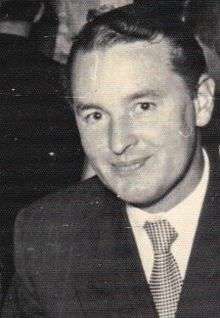Neil Davey
| "Mr Decimal" Dr Neil William Davey AO | |
|---|---|
 Davey as CEO and Secretary, Decimal Currency Board, early 1960s | |
| Born |
2 February 1921 Wangaratta, Vic, Australia |
| Residence | Canberra |
| Education | Frankston High School, Vic, Australia, & University of Melbourne, Vic, Australia |
| Alma mater | London School of Economics, London, UK |
| Organization | The Treasury, Canberra, ACT, Australia |
| Known for | CEO & Secretary of the Decimal Currency Board |
| Notable work | PhD dissertation: "The Decimal Coinage Controversy in England" |
Dr Neil William Davey AO rose to oversee Australia’s transition from pounds, shillings and pence to decimal currency. He was referred to in the media as Australia's "Mr Decimal".[1][2][3]
Life and education
Neil William Davey was born in Wangaratta, Victoria, Australia, on 2 February 1921, the son of a general storekeeper. In 1950, he graduated from the University of Melbourne with Bachelor of Commerce (equal first 1st class Honours). He completed his Doctor of Philosophy in the Faculty of Economics at the London School of Economics in 1957. His field of study was the history of monetary thought and his PhD dissertation was titled The Decimal Coinage Controversy in England.
Work: Decimal Currency Committee and Decimal Currency Board
In an Australian Financial Review article dated 12 February 2016 “How a New Currency Reflected the Confidence of a Nation", Selwyn Cornish, official historian of the Reserve Bank of Australia and honorary associate professor in the Research School of Economics at the Australian National University, stated “Davey was responsible for two critical decisions.[4] Against the advice of some of his superiors in the Treasury, who argued in favour of basing the new currency on the pound (20 shillings), Davey took a contrary view, arguing that 10 shillings be used as the base. With 12 pence to the shilling, and using 10 shillings as the base for the new currency, one cent would be equivalent to 1.2 pence. In contrast, using the pound as the base, a cent would be worth 2.4 pence. Davey regarded this to be too high. It would give rise to higher prices and would probably require the circulation of a half-cent coin. As with the naming of the new currency, commonsense prevailed. Davey was also successful in arguing that owners of cash registers and other accounting machines should be subsidised for the cost of converting their machines to the decimal system. This, too, assisted the smooth transfer to the new currency.”
On 2 May 1969 Sir Walter D Scott wrote to the Prime Minister William McMahon: “Of the Board staff, every Member of both the Decimal Currency Committee and the Decimal Currency Board would undoubtedly confirm that as Secretary of both, Dr. Neil Davey made an outstanding contribution."
At the Board, from 1963 – 1966, Dr. Davey carried a major part of the intensive planning, organisation and administration that characterised the Changeover, especially in the key years 1965 – 66. Moreover, he exhibited the personal qualities needed to produce the best from the Board’s staff. It would be difficult for me to imagine anybody quite matching the example he set and the degree of effectiveness he achieved. I cannot speak too highly of Dr. Davey’s contribution to any success the Changeover achieved.”[5]
In October 2015 Terry Larkin (Principal Private Secretary to the Treasurer Harold Holt 1960 and 1962) stated: “Neil’s superior intellectual and managerial gifts applied to public service at the highest level of government give Neil a lasting place in the economic history of Australia – most notably in the ‘nation building’ event of Australia’s change to its own, unique decimal currency in February 1966 – and before and afterwards in the direction and expansion of Australia’s overseas economic and financial relations, especially in Asia.” On 10 August 2015 the Director-General of the National Archives of Australia, David Fricker, referred to Davey’s thesis as the “foundation document” upon which the national change to decimal currency was based.[6]
Davey was made an Officer of the Order of Australia in the 2016 Queen's Birthday Honours.[7]
References
- ↑ Day, Christopher. "The Quiet Academic They Are Calling Mr Decimal". The Sydney Morning Herald. Fairfax Media. Retrieved 21 March 2016.
- ↑ Warden, Ian. "Gang-gang. The Day Australia Came to its Centses". The Canberra Times. Fairfax Media. Archived from the original on 3 May 2016.
- ↑ Doherty, Megan (11 February 2016). "50 years of dollars and cents - The Royal Australian Mint celebrates the 50th anniversary of the change to decimal currency". The Canberra Times. Fairfax Media. Archived from the original on 3 May 2016.
- ↑ "How a New Currency Reflected the Confidence of a Nation". Australian Financial Review. 12 February 2016.
- ↑ Walter Scott letter to PM McMahon May 2, 1969
- ↑ National Archives of Australia: M5482, 1, Copyright Dr Neil Davey
- ↑ Doherty, Megan (13 June 2016). "Queen's Birthday Honours 2016: Australia's Mr Decimal given just reward for all his common cents". The Canberra Times. Fairfax Media. Archived from the original on 13 June 2016.